

Native and Carolinian - Ontario’s Plants For Ontario’s Gardens

In recent years, much attention has been given to protecting and conserving Ontario's beautiful, useful, and sometimes rare
native plant material. Southern Ontario is on the northern fringe of the vast Carolinian forest area of North America which at
one time stretched from South Carolina to Northern Ontario. Many of the Carolinian plant species are very rare and on the
verge of extinction. Planting of these plants on private lands and the use of native and Carolinian species in landscaping will
help to assure the continuation of this valuable part of our Canadian heritage for future generations to enjoy.
Benefits of Native Species:

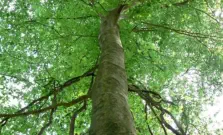
American Beech
Spring gray foliage turns dark green, then harvest gold in Fall. Grows to >20 m. Spread - 15 m.

American Fringe Tree
Small ornamental tree Large clusters of lightly fragrant white flowers in Spring Height - 4-6 m. Spread - 4-6 mm.
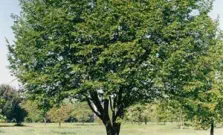
American Hornbeam
Best in partial shade, but will tolerate full sun Slow growth rate Seeds attract birds Height - 9 m. Spread - 6 m.
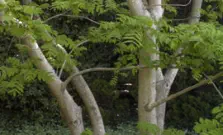
Butternut Hickory
Long tap root Leaves turn yellow in Fall Height - up to 25 m. Spread - up to 15 m.
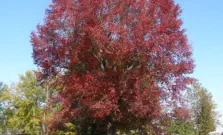
Black Gum
Dark green leaves turn intense red with hues of orange, yellow and purple in Fall Height - 9-15 m. Spread - 6-9 m.
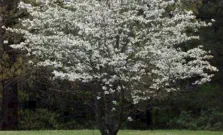
Flowering Dogwood
White
Popular flowering tree Apply thick mulch to keep roots cool. Height - 5-9 m. Spread - 5 - 7 m.
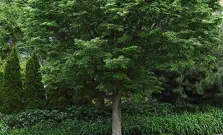
Hackberry
Good shade / privacy tree Tolerates many soils, strong winds Height - 12-18 m. Spread - 12-18 m.

Iron Wood
Hardest, densest wood in Canada Excellent fuel wood, but difficult to split Height - 7-12 m. Spread - 7-12 m.
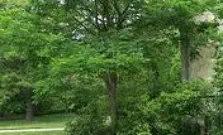
Kentucky Coffee Tree
Up to 90 cm. long leaves Full sun or partial shade Height - 20 m. Spread - 15 m.

Ohio Buckeye
Large compound leaves Yellow - green Spring flowers Prefers partial shade Height - 8 m. Spread - 6 m.

Bur Oak
Most wide spread oak in Canada Slow grower Dense shade Height - 24 m. Spread - 24 m.
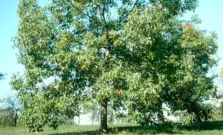
Oak Chinkapin
Smaller, glossy, yellow- green coarsely-toothed leaves Height - 15 m. Spread - 18 m.
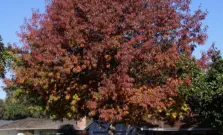
Oak Red
Leaves emerge pinkish-red, turn dark green in Summer, then red in Autumn Height - 18-22 m. Spread - 13 m.
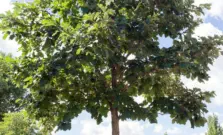
Oak Swamp White
Long-living (>300 years) Good shade or street tree Tolerant to compacted soil and drought. Height - 18 m. Spread - 18 m.
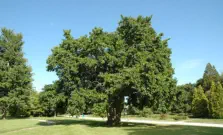
Osage Orange
Known for it’s “ugly” fruit Drought and wet tolerant Likes full sun Height - 15 m. Spread - 12 m.
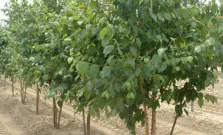
Paper Birch Clump
Multi-stemmed oval form Dark green foliage, turns gold in Fall Height - 15 m. Spread - 11 m.

Paw Paw
Unique, delicious fruit that are encouraged by full sun Pest and disease free Height - 6 m. Spread - 6 m.

Black Walnut
Great shade tree, disease free and pest resistant Tasty nuts Roots may harm nearby plants Height - 22 m. Spread - 22 m.
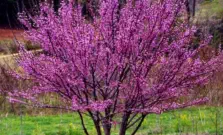
Red Bud Multistem
Abundant pink Spring blossoms Likes full sun to partial shade Height - 9 m. Spread - 10 m.Native Shrubs

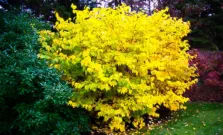
SpiceBush
Slow grower Dense yellow flowers yield glossy red fruit Glossy green tapered leaves turn golden-yellow in Fall Height - 3 m. Spread - 3 m.
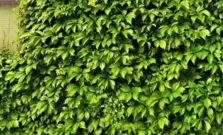
Virginia Creeper
Rapid grower White late Summer flowers produce darkblue fruit in early Fall. Height - 22 m. Spread - 22 m.Native Evergreens

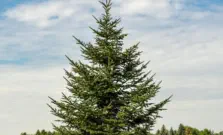
Balsam Fir
Tall, narrow, skinny pointed top Tolerates shade, variety of soils Popular Christmas tree Height - 22 m. Spread - 7 m.
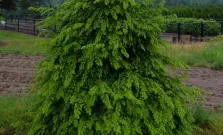
Canadian Hemlock
Pyramidal shape Soft green needles Lower branches may touch the ground Height - 21 m. Spread - 11 m.
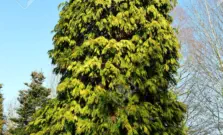
Cedar White
Prefers moist soil, tolerates some shade Deer like twigs in Winter Height - 15 m. Spread - 5 m.

Eastern Red Cedar
Soil type tolerant, likes sun Drought resistant Good windbreak tree choice Height - 12 m. Spread - 6 m.
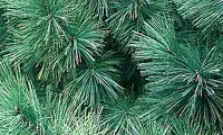
Eastern White Pine
Skinny needles 6 to 12 cm. long grown in bunches of five 8 - 20 cm. long cones Height - 24 m. Spread - 12 m.
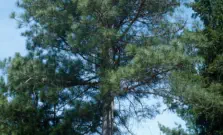
Red Pine
Tall straight trunk, beautiful red bark Moderate growth rate Prefers dry, loose sandy soil, low pH, full sun Height - 30 m. Spread - 22 m.
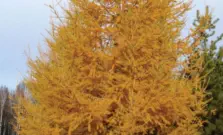
Tamarak
Bright blue-green foliage turns gold-yellow in Fall Loses it’s needles in Winter Height - 15 m. Spread - 5 m.
•
Creates a food web that increases wildlife such as songbirds and pollinators
•
Cools local climate through transpiration by actively growing during the hottest part of the year
•
Deters weeds and invasive species
•
Appropriate for the region's soil, hydrology, climate and natural rainfall
•
Absorbs excess nutrients from runoff, enhancing infiltration during periods of heavy rain
•
Drought tolerant
•
Naturally resistent to many diseases and insect pests
•
Create deep and extensive root systems, which help to stabilize the soil column and create an environment favorable to
building fertile soil rich in organic matter
Native Trees



Native and Carolinian - Ontario’s
Plants For Ontario’s GardensBenefits of Native Species:

In recent years, much attention has been given to
protecting and conserving Ontario's beautiful,
useful, and sometimes rare native plant material.
Southern Ontario is on the northern fringe of the
vast Carolinian forest area of North America which
at one time stretched from South Carolina to
Northern Ontario. Many of the Carolinian plant
species are very rare and on the verge of
extinction. Planting of these plants on private
lands and the use of native and Carolinian species
in landscaping
will help to assure the continuation of this valuable
part of our Canadian heritage for future
generations to enjoy.
Copyright © Windover Nurseries Inc.

Native Evergreens


American Fringe Tree
Small ornamental tree Large clusters of lightly fragrant white flowers in Spring Height - 4-6 m. Spread - 4-6 mm.

American Hornbeam
Best in partial shade, but will tolerate full sun Slow growth rate Seeds attract birds Height - 9 m. Spread - 6 m.

American Beech
Spring gray foliage turns dark green, then harvest gold in Fall. Grows to >20 m. Spread - 15 m.

Basswood
Excellent shade tree, pest resistant, aromatic flowers. Height - 35 m. Spread - 10 m.

Butternut Hickory
Long tap root Leaves turn yellow in Fall Height - up to 25 m. Spread - up to 15 m.
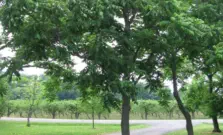
Butternut
Produces edible nut for small animals Gorgeous flowers Needs full sun Height - 18 m. Spread - 15 m.
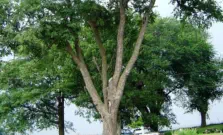
Black Cherry
Wood valued for furniture Edible berries Height - up to 22 m. Spread - 9 m.

Black Gum
Dark green leaves turn intense red with hues of orange, yellow and purple in Fall Height - 9-15 m. Spread - 6-9 m.

Flowering Dogwood
White
Popular flowering tree Apply thick mulch to keep roots cool. Height - 5-9 m. Spread - 5 - 7 m.

Hackberry
Good shade / privacy tree Tolerates many soils, strong winds Height - 12-18 m. Spread - 12-18 m.

Iron Wood
Hardest, densest wood in Canada Excellent fuel wood, but difficult to split Height - 7-12 m. Spread - 7-12 m.

Kentucky Coffee Tree
Up to 90 cm. long leaves Full sun or partial shade Height - 20 m. Spread - 15 m.

Ohio Buckeye
Large compound leaves Yellow - green Spring flowers Prefers partial shade Height - 8 m. Spread - 6 m.

Bur Oak
Most wide spread oak in Canada Slow grower Dense shade Height - 24 m. Spread - 24 m.

Oak Chinkapin
Smaller, glossy, yellow-green coarsely- toothed leaves Height - 15 m. Spread - 18 m.

Oak Red
Leaves emerge pinkish-red, turn dark green in Summer, then red in Autumn Height - 18-22 m. Spread - 13 m.

Oak Swamp White
Long-living (>300 years) Good shade or street tree Tolerant to compacted soil and drought. Height - 18 m. Spread - 18 m.

Osage Orange
Known for it’s “ugly” fruit Drought and wet tolerant Likes full sun Height - 15 m. Spread - 12 m.

Paper Birch Clump
Multi-stemmed oval form Dark green foliage, turns gold in Fall Height - 15 m. Spread - 11 m.

Paw Paw
Unique, delicious fruit that are encouraged by full sun Pest and disease free Height - 6 m. Spread - 6 m.

SpiceBush
Slow grower Dense yellow flowers yield glossy red fruit Glossy green tapered leaves turn golden- yellow in Fall Height - 3 m. Spread - 3 m.

Virginia Creeper
Rapid grower White late Summer flowers produce darkblue fruit in early Fall. Height - 22 m. Spread - 22 m.

Balsam Fir
Tall, narrow, skinny pointed top Tolerates shade, variety of soils Popular Christmas tree Height - 22 m. Spread - 7 m.

Canadian Hemlock
Pyramidal shape Soft green needles Lower branches may touch the ground Height - 21 m. Spread - 11 m.

Cedar White
Prefers moist soil, tolerates some shade Deer like twigs in Winter Height - 15 m. Spread - 5 m.

Eastern Red Cedar
Soil type tolerant, likes sun Drought resistant Good windbreak tree choice Height - 12 m. Spread - 6 m.

Eastern White Pine
Skinny needles 6 to 12 cm. long grown in bunches of five 8 - 20 cm. long cones Height - 24 m. Spread - 12 m.

Red Pine
Tall straight trunk, beautiful red bark Moderate growth rate Prefers dry, loose sandy soil, low pH, full sun Height - 30 m. Spread - 22 m.

Tamarak
Bright blue-green foliage turns gold- yellow in Fall Loses it’s needles in Winter Height - 15 m. Spread - 5 m.

Black Walnut
Great shade tree, disease free and pest resistant Tasty nuts Roots may harm nearby plants Height - 22 m. Spread - 22 m.

Red Bud Multistem
Abundant pink Spring blossoms Likes full sun to partial shade Height - 9 m. Spread - 10 m.
•
Creates a food web that increases wildlife
such as songbirds and pollinators
•
Cools local climate through transpiration by
actively growing during the hottest part of the
year
•
Deters weeds and invasive species
•
Appropriate for the region's soil, hydrology,
climate and natural rainfall
•
Absorbs excess nutrients from runoff,
enhancing infiltration during periods of heavy
rain
•
Drought tolerant
•
Naturally resistent to many diseases and
insect pests
•
Create deep and extensive root systems,
which help to stabilize the soil column and
create an environment favorable to building
fertile soil rich in organic matter
Native Bushes
Native Trees


Native and Carolinian - Ontario’s
Plants For Ontario’s Gardens
Benefits of Native Species:
In recent years, much attention has
been given to protecting and
conserving Ontario's beautiful, useful,
and sometimes rare native plant
material.
Southern Ontario is on the northern
fringe of the vast Carolinian forest
area of North America which at one
time stretched from South Carolina to
Northern Ontario. Many of the
Carolinian plant species are very rare
and on the verge of extinction.
Planting of these plants on private
lands and the use of native and
Carolinian species in landscaping will
help to assure the continuation of this
valuable part of our Canadian
heritage for future generations to
enjoy.
Copyright © Windover Nurseries Inc.


Native Trees
Native Shrubs
Native Evergreens


American Beech
Spring gray foliage turns dark green, then harvest gold in Fall. Grows to >20 m. Spread - 15 m.

American Fringe Tree
Small ornamental tree Large clusters of lightly fragrant white flowers in Spring Height - 4-6 m. Spread - 4-6 mm.

American Hornbeam
Best in partial shade, but will tolerate full sun Slow growth rate Seeds attract birds Height - 9 m. Spread - 6 m.

Basswood
Excellent shade tree, pest resistant, aromatic flowers. Height - 35 m. Spread - 10 m.

Butternut Hickory
Long tap root Leaves turn yellow in Fall Height - up to 25 m. Spread - up to 15 m.

Butternut
Produces edible nut for small animals Gorgeous flowers Needs full sun Height - 18 m. Spread - 15 m.

Black Cherry
Wood valued for furniture Edible berries Height - up to 22 m. Spread - 9 m.

Black Gum
Dark green leaves turn intense red with hues of orange, yellow and purple in Fall Height - 9-15 m. Spread - 6-9 m.

Flowering Dogwood
White
Popular flowering tree Apply thick mulch to keep roots cool. Height - 5-9 m. Spread - 5 - 7 m.

Hackberry
Good shade / privacy tree Tolerates many soils, strong winds Height - 12-18 m. Spread - 12-18 m.

Iron Wood
Hardest, densest wood in Canada Excellent fuel wood, but difficult to split Height - 7-12 m. Spread - 7-12 m.

Kentucky Coffee Tree
Up to 90 cm. long leaves Full sun or partial shade Height - 20 m. Spread - 15 m.

Ohio Buckeye
Large compound leaves Yellow - green Spring flowers Prefers partial shade Height - 8 m. Spread - 6 m.

Bur Oak
Most wide spread oak in Canada Slow grower Dense shade Height - 24 m. Spread - 24 m.

Oak Chinkapin
Smaller, glossy, yellow-green coarsely- toothed leaves Height - 15 m. Spread - 18 m.

Oak Red
Leaves emerge pinkish-red, turn dark green in Summer, then red in Autumn Height - 18-22 m. Spread - 13 m.

Oak Swamp White
Long-living (>300 years) Good shade or street tree Tolerant to compacted soil and drought. Height - 18 m. Spread - 18 m.

Osage Orange
Known for it’s “ugly” fruit Drought and wet tolerant Likes full sun Height - 15 m. Spread - 12 m.

Paper Birch Clump
Multi-stemmed oval form Dark green foliage, turns gold in Fall Height - 15 m. Spread - 11 m.

Paw Paw
Unique, delicious fruit that are encouraged by full sun Pest and disease free Height - 6 m. Spread - 6 m.

SpiceBush
Slow grower Dense yellow flowers yield glossy red fruit Glossy green tapered leaves turn golden- yellow in Fall Height - 3 m. Spread - 3 m.

Virginia Creeper
Rapid grower White late Summer flowers produce darkblue fruit in early Fall. Height - 22 m. Spread - 22 m.

Balsam Fir
Tall, narrow, skinny pointed top Tolerates shade, variety of soils Popular Christmas tree Height - 22 m. Spread - 7 m.

Canadian Hemlock
Pyramidal shape Soft green needles Lower branches may touch the ground Height - 21 m. Spread - 11 m.

Cedar White
Prefers moist soil, tolerates some shade Deer like twigs in Winter Height - 15 m. Spread - 5 m.

Eastern Red Cedar
Soil type tolerant, likes sun Drought resistant Good windbreak tree choice Height - 12 m. Spread - 6 m.

Eastern White Pine
Skinny needles 6 to 12 cm. long grown in bunches of five 8 - 20 cm. long cones Height - 24 m. Spread - 12 m.

Red Pine
Tall straight trunk, beautiful red bark Moderate growth rate Prefers dry, loose sandy soil, low pH, full sun Height - 30 m. Spread - 22 m.

Tamarak
Bright blue-green foliage turns gold- yellow in Fall Loses it’s needles in Winter Height - 15 m. Spread - 5 m.

Black Walnut
Great shade tree, disease free and pest resistant Tasty nuts Roots may harm nearby plants Height - 22 m. Spread - 22 m.

Red Bud Multistem
Abundant pink Spring blossoms Likes full sun to partial shade Height - 9 m. Spread - 10 m.
•
Creates a food web that
increases wildlife such as
songbirds and pollinators
•
Cools local climate through
transpiration by actively growing
during the hottest part of the year
•
Deters weeds and invasive
species
•
Appropriate for the region's soil,
hydrology, climate and natural
rainfall
•
Absorbs excess nutrients from
runoff, enhancing infiltration
during periods of heavy rain
•
Drought tolerant
•
Naturally resistent to many
diseases and insect pests
•
Create deep and extensive root
systems, which help to stabilize
the soil column and create an
environment favorable to building
fertile soil rich in organic matter

Native and Carolinian -
Ontario’s Plants For
Ontario’s Gardens
Benefits of Native Species:
In recent years, much attention
has been given to protecting
and conserving Ontario's
beautiful, useful, and sometimes
rare native plant material.
Southern Ontario is on the
northern fringe of the vast
Carolinian forest area of North
America which at one time
stretched from South Carolina to
Northern Ontario. Many of the
Carolinian plant species are
very rare and on the verge of
extinction. Planting of these
plants on private lands and the
use of native and Carolinian
species in landscaping will help
to assure the continuation of this
valuable part of our Canadian
heritage for future generations
to enjoy.
Copyright © Windover Nurseries Inc.

Native Trees
Native Shrubs
Native Evergreens


American Beech
Spring gray foliage turns dark green, then harvest gold in Fall. Grows to >20 m. Spread - 15 m.

American Fringe Tree
Small ornamental tree Large clusters of lightly fragrant white flowers in Spring Height - 4-6 m. Spread - 4-6 mm.

American Hornbeam
Best in partial shade, but will tolerate full sun Slow growth rate Seeds attract birds Height - 9 m. Spread - 6 m.

Basswood
Excellent shade tree, pest resistant, aromatic flowers. Height - 35 m. Spread - 10 m.

Butternut Hickory
Long tap root Leaves turn yellow in Fall Height - up to 25 m. Spread - up to 15 m.

Butternut
Produces edible nut for small animals Gorgeous flowers Needs full sun Height - 18 m. Spread - 15 m.

Black Cherry
Wood valued for furniture Edible berries Height - up to 22 m. Spread - 9 m.

Black Gum
Dark green leaves turn intense red with hues of orange, yellow and purple in Fall Height - 9-15 m. Spread - 6-9 m.

Flowering Dogwood
White
Popular flowering tree Apply thick mulch to keep roots cool. Height - 5-9 m. Spread - 5 - 7 m.

Hackberry
Good shade / privacy tree Tolerates many soils, strong winds Height - 12-18 m. Spread - 12-18 m.

Iron Wood
Hardest, densest wood in Canada Excellent fuel wood, but difficult to split Height - 7-12 m. Spread - 7-12 m.

Kentucky Coffee Tree
Up to 90 cm. long leaves Full sun or partial shade Height - 20 m. Spread - 15 m.

Ohio Buckeye
Large compound leaves Yellow - green Spring flowers Prefers partial shade Height - 8 m. Spread - 6 m.

Bur Oak
Most wide spread oak in Canada Slow grower Dense shade Height - 24 m. Spread - 24 m.

Oak Chinkapin
Smaller, glossy, yellow-green coarsely- toothed leaves Height - 15 m. Spread - 18 m.

Oak Red
Leaves emerge pinkish-red, turn dark green in Summer, then red in Autumn Height - 18-22 m. Spread - 13 m.

Oak Swamp White
Long-living (>300 years) Good shade or street tree Tolerant to compacted soil and drought. Height - 18 m. Spread - 18 m.

Osage Orange
Known for it’s “ugly” fruit Drought and wet tolerant Likes full sun Height - 15 m. Spread - 12 m.

Paper Birch Clump
Multi-stemmed oval form Dark green foliage, turns gold in Fall Height - 15 m. Spread - 11 m.

Paw Paw
Unique, delicious fruit that are encouraged by full sun Pest and disease free Height - 6 m. Spread - 6 m.

SpiceBush
Slow grower Dense yellow flowers yield glossy red fruit Glossy green tapered leaves turn golden- yellow in Fall Height - 3 m. Spread - 3 m.

Virginia Creeper
Rapid grower White late Summer flowers produce darkblue fruit in early Fall. Height - 22 m. Spread - 22 m.

Balsam Fir
Tall, narrow, skinny pointed top Tolerates shade, variety of soils Popular Christmas tree Height - 22 m. Spread - 7 m.

Canadian Hemlock
Pyramidal shape Soft green needles Lower branches may touch the ground Height - 21 m. Spread - 11 m.

Cedar White
Prefers moist soil, tolerates some shade Deer like twigs in Winter Height - 15 m. Spread - 5 m.

Eastern Red Cedar
Soil type tolerant, likes sun Drought resistant Good windbreak tree choice Height - 12 m. Spread - 6 m.

Eastern White Pine
Skinny needles 6 to 12 cm. long grown in bunches of five 8 - 20 cm. long cones Height - 24 m. Spread - 12 m.

Red Pine
Tall straight trunk, beautiful red bark Moderate growth rate Prefers dry, loose sandy soil, low pH, full sun Height - 30 m. Spread - 22 m.

Tamarak
Bright blue-green foliage turns gold- yellow in Fall Loses it’s needles in Winter Height - 15 m. Spread - 5 m.

Black Walnut
Great shade tree, disease free and pest resistant Tasty nuts Roots may harm nearby plants Height - 22 m. Spread - 22 m.

Red Bud Multistem
Abundant pink Spring blossoms Likes full sun to partial shade Height - 9 m. Spread - 10 m.
•
Creates a food web that
increases wildlife such as
songbirds and pollinators
•
Cools local climate through
transpiration by actively
growing during the hottest part
of the year
•
Deters weeds and invasive
species
•
Appropriate for the region's
soil, hydrology, climate and
natural rainfall
•
Absorbs excess nutrients from
runoff, enhancing infiltration
during periods of heavy rain
•
Drought tolerant
•
Naturally resistent to many
diseases and insect pests
•
Create deep and extensive
root systems, which help to
stabilize the soil column and
create an environment
favorable to building fertile soil
rich in organic matter






















